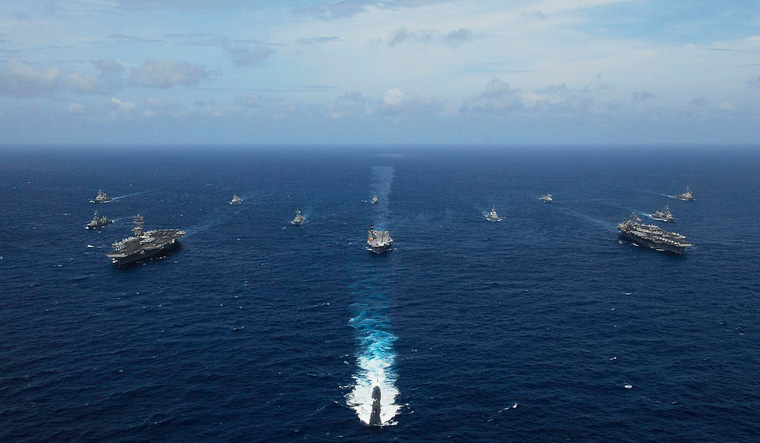
New Delhi- The first phase of the Malabar naval exercise featuring navies of India, the US, Japan and Australia will take place from November 3 to 6 in the Bay of Bengal off Visakhapatnam coast, officials said on Friday.
The second phase of the mega exercise is scheduled to be held from November 17 to 20 in the Arabian sea, they said.
Last week, India announced that Australia will be part of the Malabar exercise which effectively makes it a drill by all four member nations of the Quad or Quadrilateral coalition.
The invitation by India to the Australian Navy for the exercise came two weeks after foreign ministers of the ‘Quad’ member nations held extensive talks in Tokyo with a focus on enhancing their cooperation in the Indo-Pacific.
The officials said the first phase of the drill would witness complex and advanced naval exercises, including surface, anti-submarine and anti-air warfare operations, besides cross-deck flying, seamanship evolutions and weapon firing exercises.
The Malabar exercise started in 1992 as a bilateral drill between the Indian Navy and the US Navy in the Indian Ocean. Japan became a permanent member of the exercise in 2015.
The annual exercise was conducted off the coast of Guam in the Philippine Sea in 2018 and off the coast of Japan in 2019.
The Indian Navy will deploy a number of key platforms in the exercise which will include destroyer Ranvijay, frigate Shivalik, off-shore patrol vessel Sukanya, fleet support ship Shakti and submarine Sindhuraj.
In addition, advanced jet trainer Hawk, long-range maritime patrol aircraft P-8I, Dornier maritime patrol aircraft, and a number of helicopters will also be participating in the exercise, the officials said.
Follow this link to join our WhatsApp group: Join Now
Be Part of Quality Journalism |
Quality journalism takes a lot of time, money and hard work to produce and despite all the hardships we still do it. Our reporters and editors are working overtime in Kashmir and beyond to cover what you care about, break big stories, and expose injustices that can change lives. Today more people are reading Kashmir Observer than ever, but only a handful are paying while advertising revenues are falling fast. |
| ACT NOW |
| MONTHLY | Rs 100 | |
| YEARLY | Rs 1000 | |
| LIFETIME | Rs 10000 | |










